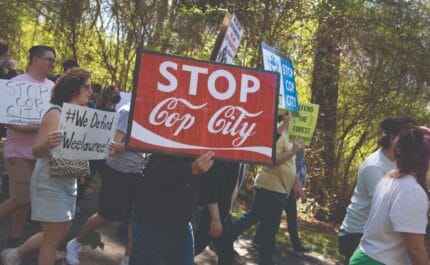On the trail of the 43
The last three months of 2014 saw Mexicans take to the streets in vast numbers to protest the disappearance of 43 students at the hands of the police. Témoris Grecko tracked the political fallout from the abduction and meets the parents who refuse to give up on their lost children
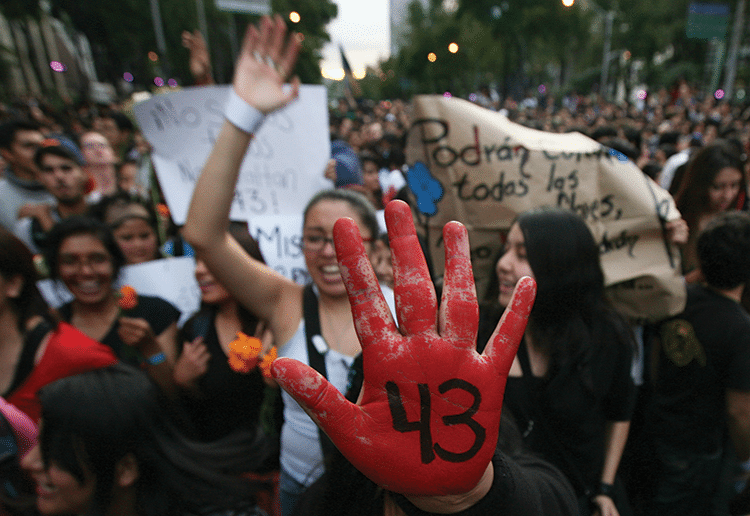
Photo: Marco Ugarte/AP/Press Association Images
13th October 2014 (Taken from: #17)
Carlos Lorenzo dreamed of being a teacher in the countryside. “I felt proud of him,” says his father, Maximino Hernández Muñoz. Carlos is the eldest of Maximino’s five children. The youngest is a three-year-old girl. “Carlos told her he’d come back with a doll for her, and every time I speak with her over the phone, she asks me where he is,” Maximino says. “I hang up because I can’t stop the tears.”
The Hernández Muñoz family are from Huajintepec, a town of 3,800 people on the easternmost edge of Guerrero State, bordering Oaxaca. It’s a beautiful part of the world: mango and tamarind plantations flank the roads and the pine-covered hills are filled with deer, jaguars and foxes. Teaching was a natural choice for 19-year-old Carlos: illiteracy is a problem locally and the name of the indigenous people he belongs to, the Amuzgo, means “place of libraries”.
It’s been four months, though, since anyone has heard from him. Between 9.30pm and 12.30am on 26th September 2014 he was part of a group that was attacked in the city of Iguala by local uniformed police. Six people were killed, 18 others were wounded and one more lies in hospital in a vegetative state. And the police took away Carlos and 42 of his fellow students, those now widely known as “los cuarenta y tres”, the 43.

Maximino Hernández (in red), father of Carlos Lorenzo, holds a sign that reads: “Taken alive! We want him back alive!” Photo: Témoris Grecko
The Mexican government says they are all dead, their bodies burned, and points to fragments of bone uncovered in the official investigation as proof. The DNA of one of them reportedly matches that of Alexander Mora, one of the missing students. The parents of the 43 don’t buy it, though. They are buoyed by a long and well-known history of official cover-ups – and by hope. “I feel they are alive, my son is alive,” Maximino tells me. It’s 26th January 2015 and he has travelled from his small coastal town to Tlalpan Avenue, an eight-lane highway which cuts through a swathe of Mexico City. We join tens of thousands of students and union workers on an 11-kilometre march from Taxqueña station to the Zócalo, the huge central square that serves as the political and emotional heart of the capital.
“The government keeps hurting us with its lies, but I’m certain our children are alive”
Three other demonstrations converge slowly on the same spot. “Porque vivos se los llevaron, vivos los queremos,” chants the crowd. “Because they took them away alive, we want them back alive.”
As night falls they light candles and listen to speakers under the glow of the illuminated cathedral and the imposing Palacio Nacional. The Zócalo is beginning to fill up and thousands more are pouring in from the surrounding side streets, eager for a chance to join the throng. One speaker reminds the people of the words recently spoken by Mexico’s president, Enrique Peña Nieto, who said he wants his people to “Get over the pain”.

Delfina de la Cruz, mother of missing student Adán Abraján de la Cruz marches holding a sign that says: “We are the students. Why do they murder us?” Photo: Témoris Grecko
“I want to ask you,” cries Epifanio, father of 19-year-old Jorge Álvarez Nava, “whether you could get over the pain of a missing son.” “Nooo!” the crowd replies in unison. He continues: “The government keeps hurting us with its lies, but I’m certain our children are alive.”
Jorge Aníbal Cruz’s mother, Carmelita, takes her turn at the microphone. “This nightmare has lasted four months already. I want to tell my son that, wherever he is, I’m looking for him.” Behind her there’s a red banner containing portraits of the 43 over the word ‘Ayotzinapa’, the informal name of the teaching academy they attended. “Don’t let Enrique Peña Nieto play the fool, we know the government has our children because uniformed people took them away,” she says. “They pretend to be searching for them but they can’t find anything because they themselves keep them hidden. Murderers from the military took our children, it was Iguala’s 27th Battalion.”
The involvement of the army, a rumour that has slowly become a certainty in the minds of some of the parents and their supporters, has turned into a delicate national security issue. Army officers claimed to have been informed “last of all” and that they couldn’t do anything to help as the students were attacked and abducted. The army’s local headquarters is 900 metres away from the crime scene but, they say, they never heard the gunfire unleashed by the police.
Out of Ayotzinapa
The Rural Teachers School Raúl Isidro Burgos, known as Ayotzinapa, is seen by some as a troublesome institution and by others as an exemplary beacon of political consciousness.
Lucio Cabañas and Genaro Vázquez Rojas, iconic leaders of the peasants’ guerrilla movements of the ’60s and ’70s, both graduated from Ayotzinapa. Its walls are covered with images from the leftist pantheon: Lucio and Genaro, of course; Marx, Engels and Lenin, Mexican revolutionary Emiliano Zapata, Che Guevara and Subcomandante Marcos, the leader of the Zapatista National Liberation Army. Rallying cries including “Ayotzinapa is the rebel call of the exploited and oppressed” are interspersed between the murals.
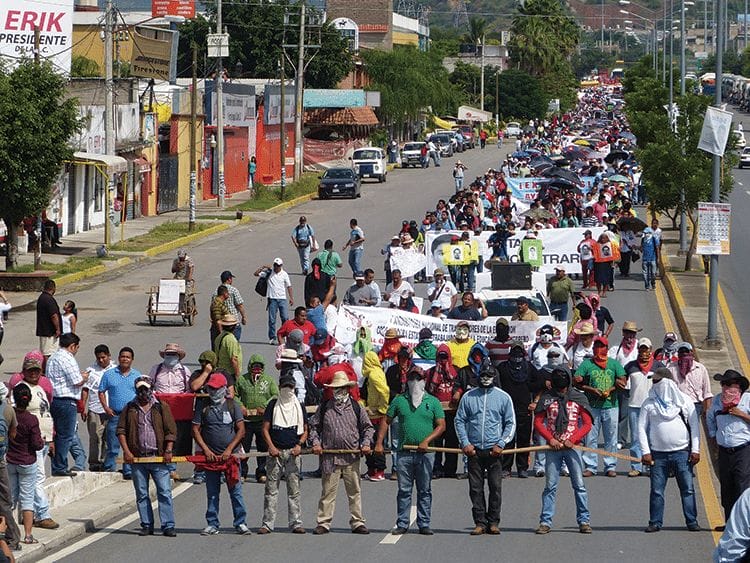
Members of a dissident left-wing teachers union demonstrate in Iguala in support of the Ayotzinapa movement, October 2014. Photo: Témoris Grecko
The federal government sees Ayotzinapa and other rural teachers’ schools, all founded in the ’30s by the socialist-leaning Lázaro Cárdenas government, as an annoyance. In the ’60s its policy was to force their closure by military or police takeover: more recently it has put them out of business by cutting their budgets. Of 44 that were open in the ’60s, only 17 remain.
Ayotzinapa also has powerful local enemies among the economic and political elites. The state’s leading families, especially the Figueroa clan, have ruled almost unchallenged over Guerrero, the country’s second poorest and least educated state. They have reason to feel antagonistic towards Ayotzinapa. In 1974, the then governor-elect, Rubén Figueroa Figueroa, was abducted by Lucio Cabañas’s Ejército de los Pobres (Army of the Poor). The ensuing military operation rescued the politician with a scorched-earth strategy that killed Cabañas – along with many innocent people.
In the struggle for their school’s survival, Ayotzinapa students routinely use demonstrations as a tool to pressure the state for budget increases. Taking possession of passenger buses run by private companies has become customary and tacitly accepted: the owners don’t sue the school but apply for government compensation for their losses. The vehicles are not normally damaged and the drivers remain at the wheel for as long as the protesters need them.
On the evening the 43 were abducted, several groups of students had been commissioned to take possession of buses needed for political activities. A second-year student, who asks me to call him “Ernesto”, travelled with a group going to the nearby town of Iguala, where they managed to pick up two more buses.
We heard many shots from different types of weapons. There was a huge roar, everybody was running in panic”
They tried to return to Ayotzinapa on Juan Álvarez street, which goes through the downtown area. It was there that police agents started to shoot at them and blocked the road with a police pick-up truck. Several of the activists got out and Ernesto and his friend Aldo Gutiérrez, 19, tried to clear the way. Aldo was shot in the head. Bullets kept coming from in front of them while, behind them, officers were arresting the passengers in the last bus. “We yelled that Aldo was dead [it turned out he wasn’t but he had suffered catastrophic brain damage],” says Ernesto. “Where were the soldiers then?” he says.
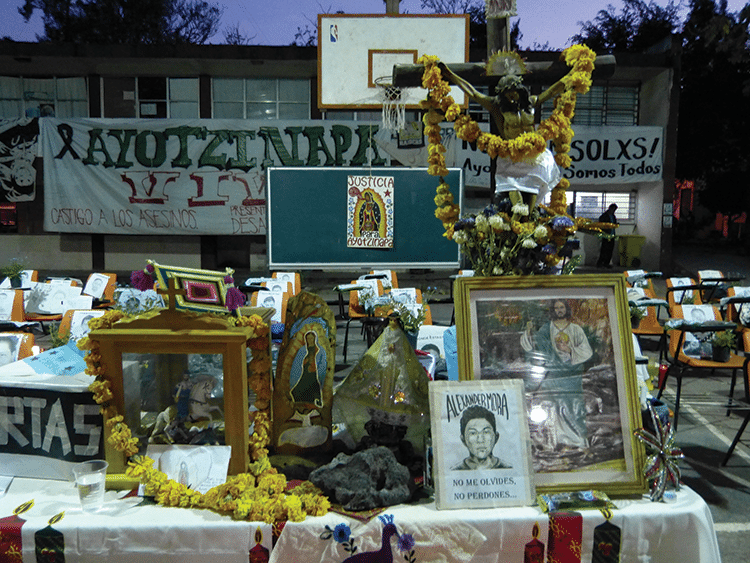
A shrine to the missing 43. Ayotzinapa, the college the students attended, has become a focus for anti-government sentiment. Photo: Témoris Grecko
More shootings took place after midnight. Teachers and union members had arrived to support the students and journalists were taking pictures when, Ernesto tells me, “we heard many shots from different types of weapons. There was a huge roar, everybody was running in panic.” Two of his fellow students died and three other civilians were killed when a bus containing teenage football players was mistakenly shot at. One of the murdered students, Julio César Mondragón, was found in a nearby street the next morning. His face had been mutilated, his eyes had been cut out and he had been left to bleed to death.
And 43 young people were missing.
The “historic truth”
The official version of what happened was published by federal general attorney Jesús Murillo Karam on 27th January 2015. He calls it the “historic truth”.
It runs like this. María de los Ángeles Pineda Villa, the wife of Iguala’s mayor, José Luis Abarca Velázquez, was holding a public event in the main square on the night of 26th September 2014 and thought that the students from Ayotzinapa meant to disturb it, so her husband ordered the local police chief to stop them. His agents attacked, arrested the 43 students and delivered them to Guerreros Unidos gang members, who took them to a neighbouring municipality’s rubbish dump. There they killed those who were still alive and rolled them down to the bottom of a hole where they improvised a gigantic incinerator and burned the corpses from 2am until mid-afternoon. The army and the federal police (those under presidential authority; other security bodies are controlled by the mayors and the state governors), so the story goes, were unaware of what was happening.
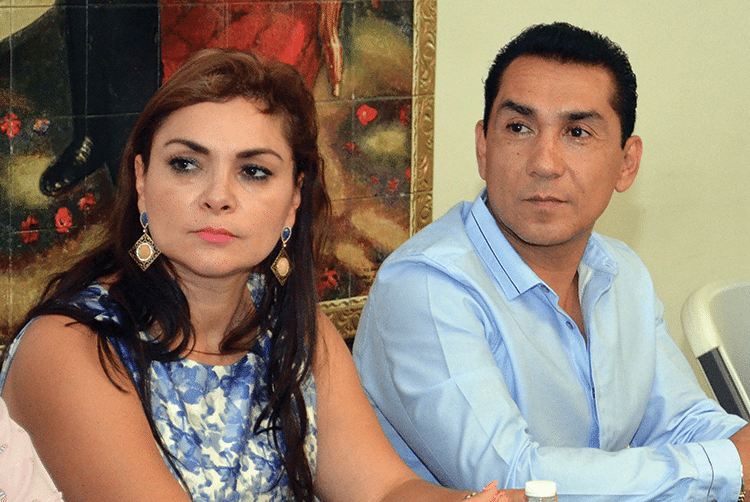
Former mayor José Luis Abarca Velázquez, right, and his wife, María de los Ángeles Pineda Villa – blamed for the abductions. Photo: Alejandrino Gonzalez/AP/Press Association Images
There are other, competing versions of the story.
A group of right-wing commentators claim that some of the students belonged to a criminal gang called Los Rojos which tried to use the students to conquer territory belonging to their rivals, Guerreros Unidos, and that the brutality that ensued was Guerreros Unidos’ attempt to set an example and discourage future attacks. Many on the left, however, believe that former mayor Abarca and his wife, Pineda, played a role in the atrocity but are being used as scapegoats to cover up the involvement of officials at higher levels, probably in the military. Most of the parents think that their children are alive, working as slaves in marijuana and poppy plantations in the mountains.
In any case, the general attorney’s “historic truth” has been disputed by a series of journalistic and scientific investigations. In an interview with presenter Carmen Aristegui on the MVS radio station on 16th December, Murillo Karam was forced to accept Proceso magazine’s assertion that the students had been followed since they left Ayotzinapa and that this information was transmitted in real time to all governmental bodies connected to the national security network, including the army and the federal police.
Murillo Karam denied that the main sources upon which he based his conclusions were statements made by criminals his men had arrested and tortured (Proceso claims to possess official health reports that prove this mistreatment took place). He also rejected students’ testimonies which claimed that federal police took part in the first attack, although he did not explain its failure to intervene even when its officers officially became aware of the incidents. “There is no [reason] to suppose they were involved,” he said. “Yes, they knew there was a demonstration… that’s in the investigation, but that doesn’t imply [the federal police’s] participation.”

Students’ images adorn school seats. Many parents believe their children are still alive, working on narcotics plantations. Photo: Témoris Grecko
Murillo Karam didn’t mention the army. Photos show that the 27th Batallion’s commander was present at the mayor’s wife’s political event. It has been officially acknowledged that soldiers showed up at a clinic at about 3am and harassed students who had sought refuge there (medical care was denied to them). It remains unexplained why they didn’t do anything sooner.
The 27th Batallion has a long, bloody history. Its involvement in the ’70s “Guerra Sucia” (Dirty War) against the guerrilla movements, ransacking villages, torturing and executing civilians and throwing bodies from airplanes in “death flights”, has been documented in the Guerrero State Truth Comission’s Final Report, released on 16th January 2015. More recently, the illegal detention and forced disappearance of six young men from Iguala on 1st March 2010, attributed to 27th Batallion’s soldiers, was denounced in a 2011 Human Rights Watch investigation.
The “historic truth” has been challenged. Scientists from Mexico’s National Autonomous University published reports stating that improvising a crematorium for 43 people in a remote rubbish dump and incinerating them in 15 hours is impossible. It is claimed that this would have left traces that were never acknowledged by the authorities, including blood and clothes from the corpses that were rolled over the trash, human fat in deeper layers of the soil, steel wires from the tyres supposedly used to fuel the fire and so on. The destruction of the remains would not have been complete and many more than a few burned-out fragments of bone would have been found.

Mothers and relatives of the 43 missing students on the way to attend a mass at the Basilica of Guadalupe in Mexico City. Photo: Marco Ugarte/AP/Press Association Images
A civil organisation was invited to join the investigation by the parents of the 43, who lacked trust in the authorities. The respected Argentine Forensic Anthropology Team (AFAT) – set up in Argentina in 1984 to investigate the disappearances of 9,000 people under the military regime – was allowed in by the federal prosecutor’s office in an attempt to gain credibility. On 7th February 2015 the team questioned Murillo Karam’s rush to reach conclusions and close the case while “the investigation has not finished, and it can’t come to an end given the nature of the crimes”. Among other irregularities, the AFAT noted that the evidence had been gathered carelessly and that it’s uncertain whether the bone fragments discovered actually belong to the missing students.
The attorney’s office called AFAT’s comments “speculations” and “far from reality”. It claimed that they had “departed from their field of expertise” and said that it “will not accept any doubts” about its own verdict.
Fresh criticism came from another quarter. On 10th February 2015, Amnesty International accused the attorney of dismissing the recommendations of “respected independent experts” (referring to AFAT) and of trying to discredit their work. The government, they said, “mainly bases its case on self-incriminatory testimonies by the detainees [supposed gang members who appear to have been tortured by the authorities] and very limited forensic evidence.”
Revolution Day
The protest campaign’s demands that the government find the 43 alive peaked on 20th November 2014. It was Revolution Day (the date that marks 1910’s Revolución Mexicana, the second-most important celebration after Independence Day) and thousands and thousands of Mexicans of all social classes flowed into the Zócalo. Middle-class professionals, indigenous people, wealthy youngsters from private universities, members of co-operatives, neighbourhood associations, artists, anarchists… all chanting what must be the longest slogan in Mexican political history: “Uno, dos, tres, cuatro, cinco…” and so forth until “Cuarenta y uno, cuarenta y dos, cuarenta y tres… ¡Justicia!”
For two and a half months, protests in the name of the disappeared took place on a near daily basis”
The protest was ended by riot police who carried out a vicious offensive that emptied the square, sparing those who were throwing rocks and targeting families for beatings and arrests instead. This sort of police brutality has been a regular occurrence over the last two years since Peña Nieto became president and his government broke an unspoken decades-long peace agreement that had kept relations mainly calm between cops and demonstrators.
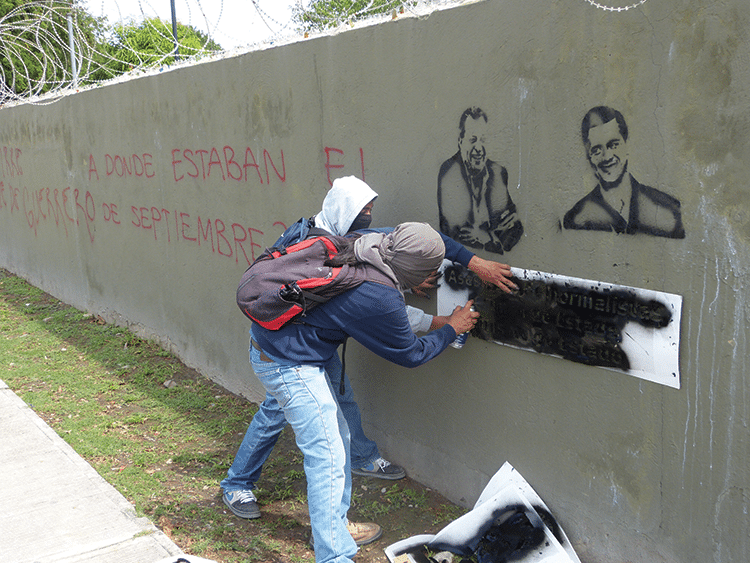
Portraits of President Peña Nieto and then-governor of Guerrero Ángel Aguirre. The caption reads: “Murderers of students. Crime of the state. Cynicism of the state.” Photo: Témoris Grecko
For two and a half months, protests in the name of the disappeared took place on a near daily basis and mass demonstrations, accompanied by a movement called Global Actions for Ayotzinapa (with events in cities around the world), were held every week. The administration’s bet was that the Christmas holidays would help demobilise the crowds, and they were right. Partially. The numbers of participants decreased and the 26th January marches, although well attended, seemed small in comparison with the ones from the autumn.
There was no respite, however, for Peña Nieto. He and his ministers were kept on the back foot by a succession of corruption scandals, policy mistakes, weak economic performances and falling oil prices. And although there were no longer daily protests, the anger about the 43 would not go away.
Some sensed a new opportunity for the far-left opposition. On 6th February, I was in Ayotzinapa for the National Popular Convention, a gathering of university groups, social organisations and popular movements from a markedly leftist political standpoint.
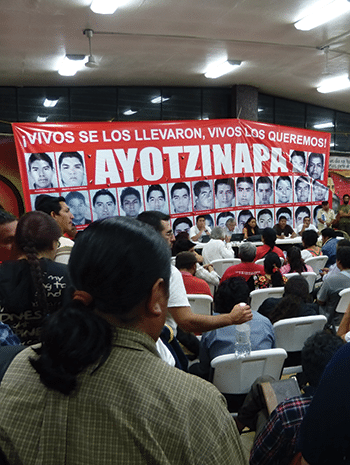
The final session of the anti-establishment National Popular Convention, held in Ayotzinapa, February 2015. Photo: Témoris Grecko
Its members believe that people shouldn’t vote when they know that they will be helping narcotraffickers to gain political influence. They point at the harsh reality of life in Guerrero state, where it’s difficult to find a politician free from links to organised crime. They realise that it’s almost impossible for clean politicians to compete with those who enjoy criminal support. They’ve got more money, stronger networks… and guns.
But the convention didn’t seem rooted in reality. Under the gaze of Marx, Engels and Lenin, about 150 delegates agreed to close the country’s borders, stop the upcoming federal elections from taking place and build a “national organisation of the people”. This last resolution was the trickiest as there were opposing views on how to achieve it. For some, the road was clear: without an election, a void was going to be created and would in turn be filled by the people through a National Popular Assembly, which would be created before the 7th June election date.
“We are going to scare people away,” warned Javier Monroy, a life-long leftist who heads the Committee of Relatives and Friends of Those Abducted, Disappeared and Murdered in Guerrero. “Truth and justice are goals that appeal to many everywhere. The more demands you add up [such as calling for a new constitution and the rule of the proletariat], the less support you’ll get. And we have a long list now.”
Confronting reality
It is not just the extreme left that has been inspired by Ayotzinapa. New grassroots groups are being born out of the “national emergency” of the 43: artists, journalists, farmers, musicians and manual labourers are gathering with the aim of cleansing Mexico of violence, impunity and corruption. They are, of course, plagued by a deep level of distrust, as similar attempts in the past have ended with leaderships and entire groups being hijacked by politicians – and nowadays few entities are as despised as political parties.
Still, people are looking to take national matters into their own hands. And others are confronting some of the most painful realities of daily life in Mexico, groups like the relatives of “los otros desaparecidos” (the other disappeared) in Iguala. Former mayor José Luis Abarca and his wife may be in prison now, accused by Murillo Karam of being solely responsible for the whole Ayotzinapa affair, but during their dark two-year reign as many as 300 people are thought to have disappeared. This is out of the 23,272 people who went missing in the country as a whole between January 2007 and October 2014, according to official figures.
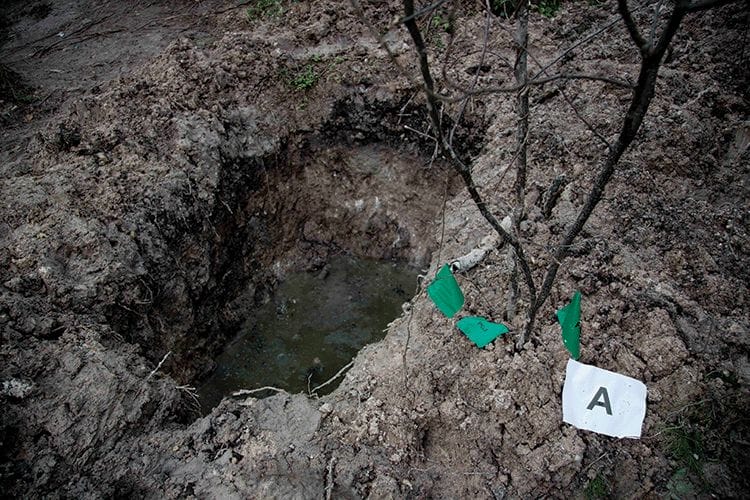
A clandestine grave in Iguala uncovered as officials worked to determine whether 28 bodies found at the site were those of the students abducted in September 2014. Photo: Marco Ugarte/AP/ Press Association Images
When her brother Tomás was abducted in July 2012, Mayra Vergara Hernández, now a member of Iguala’s Committee of Families of Victims of Forced Disappearance, says that “we didn’t even look for him; we were afraid more of us would vanish”. But they gained new confidence when the search for the 43 began and “they started finding bodies”.
Mayra witnessed the behaviour of the authorities with dismay: once it had been proved the initial 28 corpses found, exhumed from secret graves on 6th October, were not those of the students, the police showed no interest in discovering their true identities or how they died. Mayra and her siblings asked themselves “whether my brother was there”.
When we find a body, we feel calm because we know that, even if it’s not our relative, that body belongs to a family”
They joined others to found the Committee and started going out to the fields in November 2014. The Cerro Gordo hill, which serves as the brownish backdrop to life in Iguala, is a colossal clandestine grave. Juan Jesús Canaán Ramírez, an uncle of two young men kidnapped in 2008, has learned to distinguish the smells brought up by an iron bar he sinks into the soil, to detect where a human body is buried. When I join them in their search, on a sunny Sunday in February, they are protected by six federal police agents, but it’s only the second time they’ve had such support: on most of their 80 expeditions, they’ve risked retaliation from criminals.
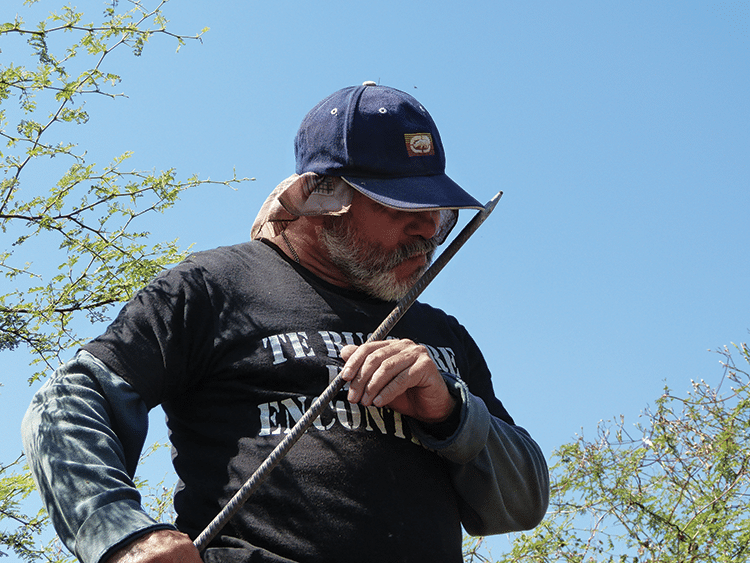
Juan Jesús Canaán Ramírez smells the iron bar he has just taken from the soil, trying to detect the scent of buried corpses. Photo: Témoris Grecko
In the context of so many murders, it would be miraculous if Canaán found his nephews’ corpses. He doesn’t care: “When we find a body, we feel calm because we know that, even if it’s not our relative, that body belongs to a family.” “Every grave is a light of hope,” Mayra tells me.
Maximino Hernández will not take any credit for the wave of inspiration that has swept over his countrymen. But he’s happy because many others, like him, have become more aware of the reality and of the need to act now.
“This has to keep going,” he tells me on Tlalpan Avenue. “God willing, if our children return, we will still carry on because another massacre, another abduction might happen. Many people feel bothered by our struggle. May God not let them go through what we are going through. It’s very sad. But we have to put order in our country.”
Slow Journalism in your inbox, plus infographics, offers and more: sign up for the free DG newsletter. Sign me up
Thanks for signing up.

